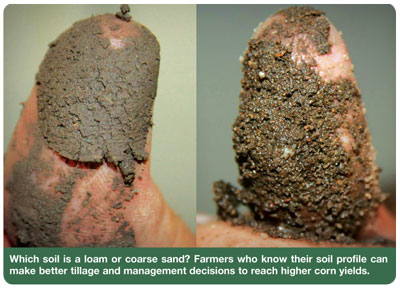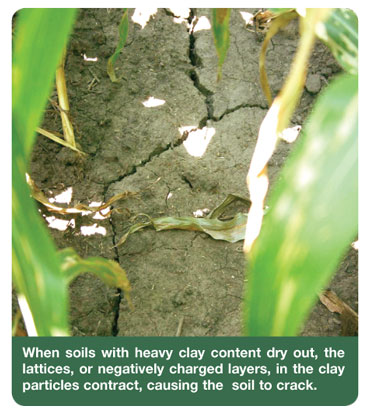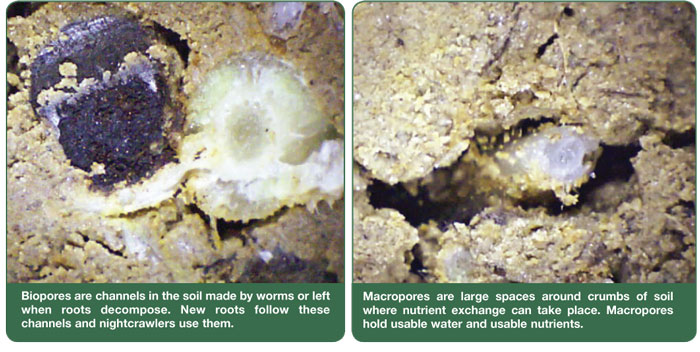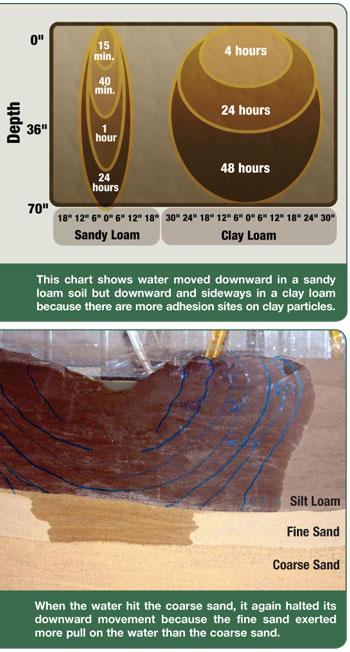What You Must Know About Soil


Think of soil as you do your employees. If you account for each one's distinct personality, he or she will be happier and more productive. Soil is like that as well—it will produce a lot, or much less, depending on how well you
understand it and how you treat it.
Like people, soil is complex. But if you understand some basic concepts, you'll be on your way to laying a foundation for high yields every year.
At the 2009 Farm Journal Corn College, Farm Journal Field Agronomist Ken Ferrie explained the conceptsP: porosity, soil structure, soil texture, root size and capillary water movement.
Soil porosity. Well-managed soil looks and feels crumblike in structure. There are three types of soil pores, which are the spaces inside or around the crumblike particles.
"The size of pores plays a big role in soil density,” Ferrie explains. "We want macropores—the large spaces where nutrient exchange can take place. Macro-pores hold usable water and nutrients. They are the spaces around crumbs of soil.
"Small pores are called micropores. They are of less benefit because they hold very little usable water or oxygen. Micropores are found inside the crumb structure of soil.
"A third kind of pore, biopores, are channels left in the soil where roots decomposed or worms or other organisms were. New roots follow those channels and nightcrawlers use them.”
Waste excreted by nightcrawlers makes biopores a nutrient-rich environment. So biopores are good, although they have one downside: In continuous corn, they may contain toxins left by decomposed corn roots.
Pores and root size. Two factors determine how large your corn root diameter will be. The first is genetics. "If we grow a plant in a hydroponic situation, the root will get as big as its genetics allow,” Ferrie says. 
The second is pore size. "If we grow the plant in soil, pore size becomes the determining factor,” he says.
"If you plant a hybrid in coarse sand, you'll get larger diameter roots because there are large macropores between the sand particles. If you plant it in tight clay, you'll get a more fibrous-looking root system, much smaller in diameter. Roots keep pushing until the soil doesn't let them expand anymore.”
Soil texture and roots. Soil texture influences pore size. Texture means particle size—from largest to smallest, sand, silt and clay. Soils contain varying amounts of the three sizes of particles. They are classified according to the proportions of each particle they contain. The highest proportion is listed first, as in "silty clay loam.”
"Clay particles are microscopic,” Ferrie explains. "To put the sizes in perspective, think of them this way: If a coarse sand particle was a 747 airliner, a silt particle would be a hang glider and a clay particle would be a hummingbird.”
Clay is different from other soil particles because it is made up of lattices—layers held apart by negative charges that repel each other. The lattices allow clay to hold water. Clay, more than anything else, gives soil its waterholding capacity. Clay's negative sites also allow it to hold tightly to positively charged nutrients.
"Clay particles also have carbon, or organic matter, a substance that allows the particles to hold nutrients,” Ferrie says. "A tablespoon of clay has enough surface area to cover a football field. All that surface area is available
for holding nutrients, so the possibilities are great.
"Sand and silt don't have lattices or negative sites, but they do have carbon, or organic matter,” Ferrie adds. "So they have some water- and nutrient-holding capacity but nothing compared with clay.
"If we evaporate water out of clay particles—out of the lattices where it is held—the particles collapse and the soil cracks. At the other extreme, sands don't crack when they dry out—they just get hot and blow away.”
To create a crumb structure containing macropores, soil particles must be pulled together into aggregates. Clay particles are essential to this process.
Adding calcium causes clay particles to "flocculate”—that is, particles are held together but also held apart. The flocculation process also requires organic matter and pectin, which is secreted by microbes found around plant roots, especially grasses.
"Through this process, we build a crumb structure, with macropores, capable of holding usable water,” Ferrie explains. "If we can keep the soil from running together and maintain the crumb-like structure, the soil will be able to take in water and oxygen.”
Quick to destroy. Demonstrations at Corn College show how structure that took 15 or 20 years to develop can rapidly be destroyed—with two years of moldboard plowing and disking, for example. "A plow brings poorer-structured soil to the surface and leaves no residue to protect it,” Ferrie says. "A disk breaks down soil structure.”
Tillage implements, such as moldboard plows and large offset disks, can break the "bridges” between the flocculated clay particles. "We also can destroy structure by letting the salts in the soil get too high or with poor drainage or overapplication of manure. Soil acidity can do the same thing if pH gets too low,” Ferrie says. "If this happens, you may see water run off a field in places where it once percolated into the soil.
"In a salt situation, we would apply calcium sulfate to flush out the salt,” Ferrie explains.
"If the problem is acidity, apply calcium carbonate. That will flush out the excess hydrogen ions that result from acidity and rebuild the bridges between the organic matter and the clay particles. It's always easier to maintain soil structure than to try to put it back in.”
How plants get water. Water moves through the soil by capillary action, which involves processes called adhesion and cohesion. Pore size and soil texture influence this movement.
Cohesion works like this: Water is one large oxygen molecule with two hydrogen molecules attached to it. That gives it polarity—a positive end and a negative end. "One molecule's positive end hooks to another molecule's negative end,” Ferrie explains. "When water runs down your pickup window in a stream, that's cohesion. The water looks like it's all hooked together, and it is.”
The hydrogen molecules hook to the negative sites on clay particles, forming a tight bond. That's adhesion. "Water inside the clay particles is not usable water because plants and microbes can't get it loose,” Ferrie says. "But hooked to that water are other water molecules, out in the macro-pores. Those molecules are hooked to each other by cohesion; that is usable water.”
In the field, adhesion and cohesion work like this: "In a soil with very high clay content, the soil contains mostly micropores,” Ferrie says. "Most of the water is held tightly to clay particles. In these soils you sometimes see corn roll, even though you can dig down 6" and find enough moisture to make a ball out of the soil. But it's not usable water.
"In a silt loam soil, we have more macropores, which contain usable water. As water is drawn to the soil particles through adhesion, it pulls more water through cohesion.
"Where the adhesion sites are, and how far apart, determines a soil's pulling power. A coarse sandy soil can't lift water very far because gravity takes over. In a finer soil, we can move the water upward. In sand, that may be 8". In a silty clay loam, it may be 3'.”
Seeing is believing. To show Corn College attendees how water moves in various soil types, Ferrie and his staff recreated a demonstration he first witnessed in junior college. They filled a box with coarse sand in the bottom, fine sand in the middle and silty clay loam on top. Then they dribbled water into an "irrigation ditch” at the surface.
In the silty clay loam, the water moved as far to the side as it did downward because of all the adhesion sites in the soil.
"When the water reaches the sand, you would expect it to move straight down,” Ferrie says. "But it doesn't—it halts its downward movement. There are so many negative sites in the silty clay loam, pulling on the water, that it seems to defy gravity. 
"This is an example of a perched water table, which you may encounter if you farm on top of a sand lens. It requires enough water to create positive pressure to push water into the sand.”
When the water hits the coarse sand, it again halts its downward movement. "The fine sand exerts more pull on the water than the coarse sand,” Ferrie says. "Eventually, we will saturate the fine sand and apply enough pressure to move the water into the coarse sand.
"But the demonstration shows that moving water up and down through the soil profile is not merely a function of drainage; rather, it's a function of pore space, adhesion and cohesion.”
Something similar can happen if we alter the structure of soil mechanically, Ferrie continues. "If we compress the soil particles together—with horizontal tillage, for example—and create a layer of micropores, water will not move either up or down. In that case, we create a perched water above the compressed layer or we hold water beneath it.”
Something else can happen if the silty clay loam dries out and cracks. "If we add water to the cracked soil, it drops straight down the cracks, creates positive pressure on the sand underneath and the water travels directly to the B horizon,” Ferrie explains.
"This happens a lot in soils like we have in central Illinois,” Ferrie says. "You get a 1½" or 2" rain on cracked soil, and a week or two later you can't figure out where the water went. It went straight down to the subsoil.”
Tillage troubles. Compressing soil and forcing out the macropores affects not only water movement but root growth, as well. Horizontal tillage is the main cause of such density changes.
"Horizontal tillage is anything done in the horizontal plain,” Ferrie says. "We're talking plows, disks, field cultivators or soil finishers.
"Remember that a corn plant's root system will expand to what the soil will allow. If soil gradually becomes more dense, the size of the root will gradually taper down. It can handle gradual density changes but not sudden ones. So when we create loose soil on top and the root suddenly hits a dense layer, it's in trouble. The root can't get through the soil, so it turns and grows horizontally.”
Here's how the scenario often plays out: Horizontal tillage loosens the soil several inches deep. The downward pressure of the implement crushes out the macropores, "tightening” the layer of soil underneath.
In the loose soil layer on top, water percolates in quickly. It also evaporates quickly, but evaporation is unable to pull water up from deeper in the soil because of the dense layer.  As for the root, it charges downward through the loose soil at a big diameter. "But when it hits the density change, it may not be able to handle it,” Ferrie says. "How great a problem results depends on which roots are turned and when. The greatest problem occurs if the third set of crown roots is turned. Those roots need to get water to the plant in July and August.”
As for the root, it charges downward through the loose soil at a big diameter. "But when it hits the density change, it may not be able to handle it,” Ferrie says. "How great a problem results depends on which roots are turned and when. The greatest problem occurs if the third set of crown roots is turned. Those roots need to get water to the plant in July and August.”
The best way to see what's going on below the surface of your fields is to dig a soil pit.
You can e-mail Darrell Smith at dsmith@farmjournal.com.







